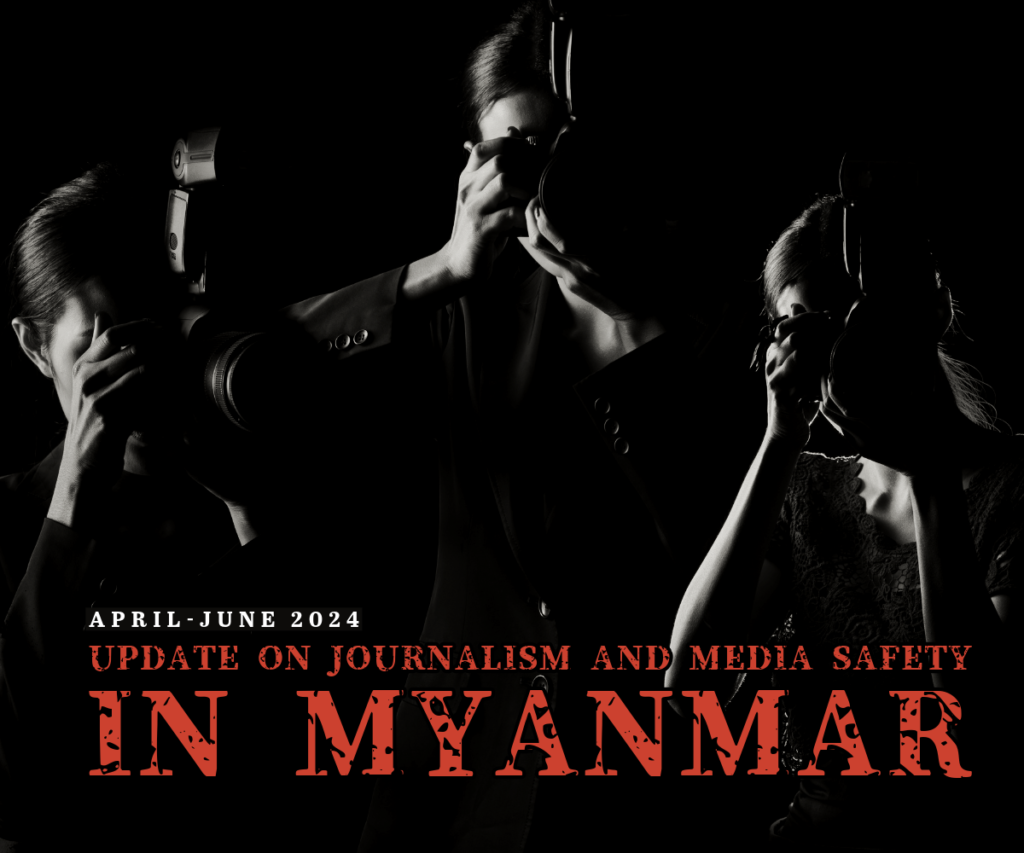
Highlights
The second quarter of 2024 saw the arrests of three journalists and former journalists in Myanmar, where armed conflict between the military junta and resistance groups has been intensifying – and now affects 80% of the country’s townships.
The pattern of heavy surveillance and suppression of media freedom, in place since the February 2021 coup, continue and has severely restricted the flow of information in the country.
Five journalists, including one who was convicted in March but whose case only became known later, were found guilty under various security-related laws, mainly the Counter-terrorism Law. These highlight a significant number of long jail sentences that have been handed down this year to journalists under security laws put in place by the State Administration Council (SAC), as the junta is called, even if the number of arrests has dropped since the early months after the coup.
A Dawei Watch journalist was sentenced to life imprisonment after being convicted under three counts of terrorism.
A reporter and a night guard from the Development Media Group were sentenced to five years in prison, also for terrorism. A journalist from The People’s Voice was sentenced to three years in prison for incitement, and another from the Democratic Voice of Burma got a four-year prison term for terrorism.
A photojournalist was released after completing his prison sentence in April. Three other journalists were included in the Junta’s prisoner amnesty announced for the Myanmar New Year in the same month.
As of June 2024, 57 Myanmar journalists and media professionals remained behind bars. Ninety-one percent of the detainees are men, and the remaining 9% are women. Seventy-eight percent of the detained journalists are reporters or photojournalists.
Cumulatively, since the coup, 213 journalists and news workers have been arrested, 75 convicted, and 157 released under the military regime, according to the latest media monitoring data on the repression of journalists in Myanmar.
The intensification and spread of armed conflict have also been affecting the news environment in different ways, beyond the clampdown on media by the junta. As ethnic armed organisations gain ground on the battlefield, their administrative organisations are also laying down policies that impact news coverage in the areas they control.
Two such local authorities have issued directives that cover journalists working in their regions, drawing expressions of concern from Myanmar journalists who worry that these could restrict the space for independent reporting. Myanmar journalists say that thus far, since the coup, they have been able to have access to these ethnic regions.
In April, the Interim Executive Council of Karenni State– described as a provisional government administering parts of the eastern state that anti-junta forces have seized control of since the coup – released an eight-point set of media reporting guidelines to be followed by all journalists seeking to carry out coverage in its areas. In the same month, the Karen National Union issued a similar directive that requires journalists to register and present identification documents, citing security reasons.
Two groups of Myanmar journalists formed after the coup – the Independent Press Council of Myanmar (IPCM) and the Independent Myanmar Journalists Association – say that while ensuring journalists’ safety and accountability as essential, the media directives could undermine press freedom and impede journalists’ ability to report effectively.
On 3 May, World Press Freedom Day, IPCM released a draft Code of Code for Myanmar journalists that will be further discussed in consultations with news professionals from the country.
Meantime, some Myanmar journalists in Bangladesh, displaced by conflict in western Rakhine state, reported that Bangladesh government officials have been demanding evidence of their identities and checking professional credentials.
Exiled journalists continue to live with challenges around safety and livelihood issues in Thailand, mainly Mae Sot and Chiang Mai where many of them are based. In an environment of declining funds from development donors and the difficulty of generating market-based revenues, some large media houses in exile have had to cut the salaries of staff, including senior management ones, by 20%.
Arrests and detention
A former chief editor at Southern Myanmar News, Myo Aung (also known as Nay Min) was arrested on 10 April in Mawlamyine. He was among the persons with Dr Aung Naing Oo, a former deputy speaker of the Mon state parliament, as he led a group that was leaving Mawlamyine to bring food and other items to help civilians displaced by clashes in Kyaikmayaw Township, Mon State. Myo Aung’s arrest has not been previously covered in the news.
Myanmar Now reported that junta forces accused Dr Aung Naing Oo of funding resistance forces and detained him and the persons in his group. They were held at the Mawlamyine police station for five days, and then released (including Myo Aung).
In May, a journalist working with an international media organisation with offices in Myanmar was arrested in Yangon. Sources confirmed that he was released in less than a week, although the reason for his detention was unclear. The journalist’s identity, background and other details are not being made public due to the sensitive nature of the situation.
Mrat Hein Tun, a former journalist from Narinjara and Border News Agency, was arrested by junta security forces on 31May, along with a youth leader from the Arakan National Party, in Hlaing township in Yangon. Since Hlaing is among the 61 townships under martial law – areas where the military, not civilian administrators or judges, have full control – Mrat Hein Tun’s case was sent to a military tribunal after his interrogation in Yangon.
